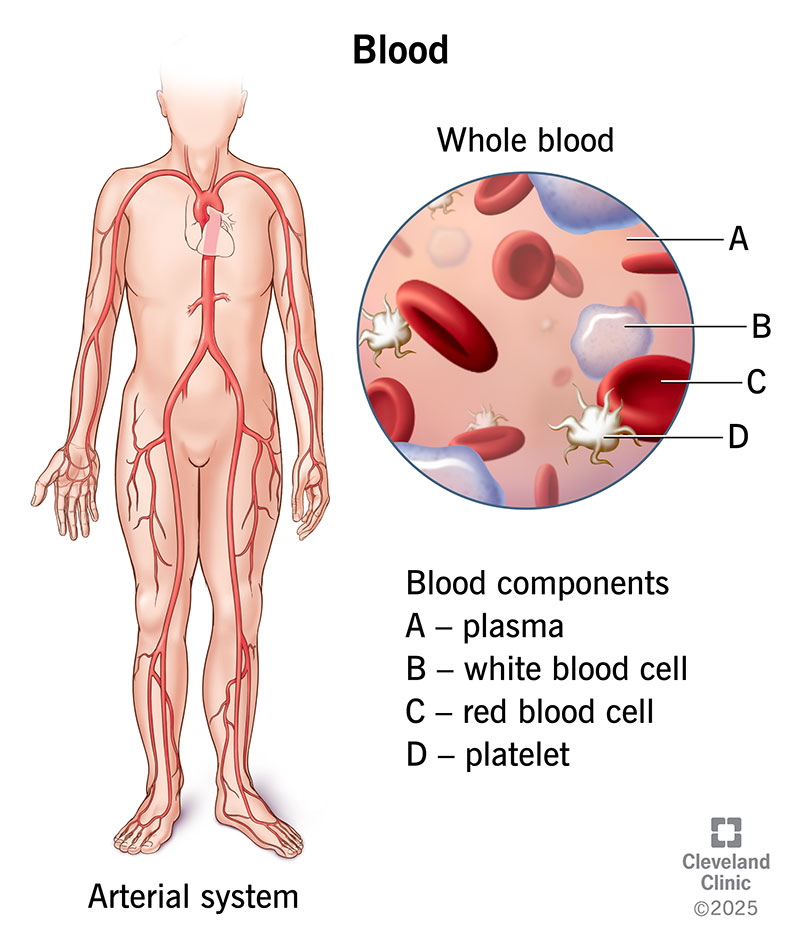Blood is specialized body fluid that constantly flows throughout your body. It has four parts. Plasma and red blood cells make up most of your blood. White blood cells and platelets account for less than 1% of your blood. Blood carries oxygen throughout your body, protects you from infections and stops the bleeding when you’re injured.
Advertisement
Cleveland Clinic is a non-profit academic medical center. Advertising on our site helps support our mission. We do not endorse non-Cleveland Clinic products or services. Policy

Blood is an essential fluid, constantly flowing and keeping your body working. It carries oxygen and nutrients to your body’s tissues. And it removes waste your body doesn’t need. It has four parts:
Advertisement
Cleveland Clinic is a non-profit academic medical center. Advertising on our site helps support our mission. We do not endorse non-Cleveland Clinic products or services. Policy
These basic parts are the same no matter your blood type. The most common blood types are A, B, AB and O.
Blood performs many vital functions. You need blood because it:
Blood flows throughout your circulatory system. Your heart pumps blood to blood vessels that move blood throughout your body:
Blood gets its start in your bone marrow (the spongy tissue inside bones). Bone marrow contains stem cells. Stem cells are the earliest form of your body’s blood cells. Blood cells mature from stem cells in your bone marrow. Once they’re fully developed, they enter your blood vessels as whole blood.
Advertisement
Blood is mostly fluid. But it also contains cells and proteins that make it (literally) thicker than water. The average adult male has about 5 liters (10.5 pints) of blood. Females have about 4 liters (8.5 pints). Blood makes up about 8% of your body weight:
Plasma is a yellowish fluid that’s more than 90% water. Its main job is to transport. It carries blood cells and essential proteins and salts throughout your body. It also carries waste products from your cells to your kidneys and liver to remove the waste. It maintains your body temperature and keeps blood cells moving through your body.
Red blood cells (erythrocytes) get their color from the protein hemoglobin. Hemoglobin helps red blood cells deliver the oxygen other cells need to make energy. Your red blood cells also carry waste (carbon dioxide) to your lungs for you to breathe out. They live about 120 days before your body makes new cells to replace them.
White blood cells (leukocytes) are part of your immune system. When germs or cancer cells launch attacks, your white blood cells find and destroy them. You have five types. Each has a unique task and timeline. More than half of your white blood cells are neutrophils, the most common type.
Platelets (thrombocytes) are plate-shaped cell fragments. They’re first on the scene any time your blood vessels are damaged and bleeding. Platelets seal damaged blood vessels by forming clots. That way, blood stays in and germs stay out. Platelets have a lifespan of about a week.
Your blood — like your red blood cells — is red. It’s bright red when it’s leaving your heart and filled with oxygen. It’s more of a dull brick red when it’s running low on oxygen and making the return trip back to your heart for more.
Both cancer and noncancerous disorders can impact how your blood works.
Blood cancer starts when there’s a change (mutation) in the genes that tell your body how to make blood cells. The mutation causes your body to make abnormal blood cells that multiply fast. Blood cancers include:
Blood disorders are noncancerous conditions where blood cells can’t do their jobs correctly. They range from harmless conditions to potentially life-threatening ones. They include:
Advertisement
Blood tests alert healthcare providers to conditions impacting your blood. Blood test results let your provider know if you have high or low blood cell counts or abnormal blood cells. This information helps providers diagnose countless conditions.
The most common symptoms of problems with your blood include:
An enlarged spleen is another common sign of blood problems. This is because your spleen filters your blood. Conditions affecting your blood cells can cause it to swell.
Your blood is a precious resource. It constantly flows through your body so everything works as it should. Your blood carries oxygen to your cells so they can create energy. It defends your body against intruders. It even manages how much you bleed. This is why it’s a good idea to call a healthcare provider if you’re noticing signs that something isn’t quite right. It’s called “lifeblood” for a reason. Blood is the fuel that powers a healthy life.
Advertisement
Cleveland Clinic’s primary care providers offer lifelong medical care. From sinus infections and high blood pressure to preventive screening, we’re here for you.

Last reviewed on 07/21/2025.
Learn more about the Health Library and our editorial process.